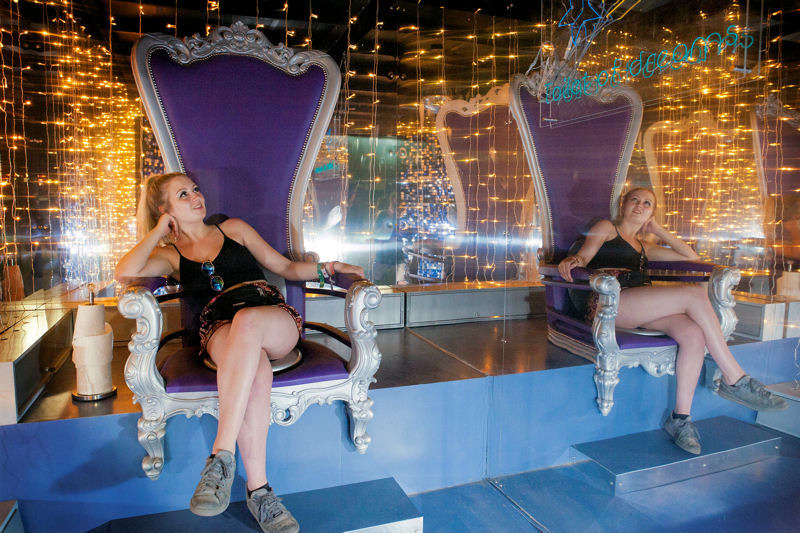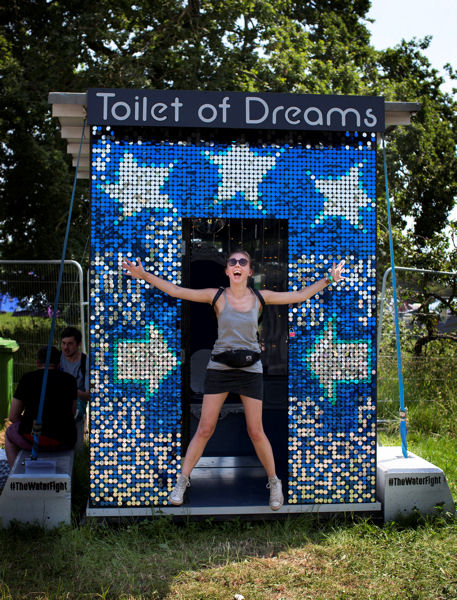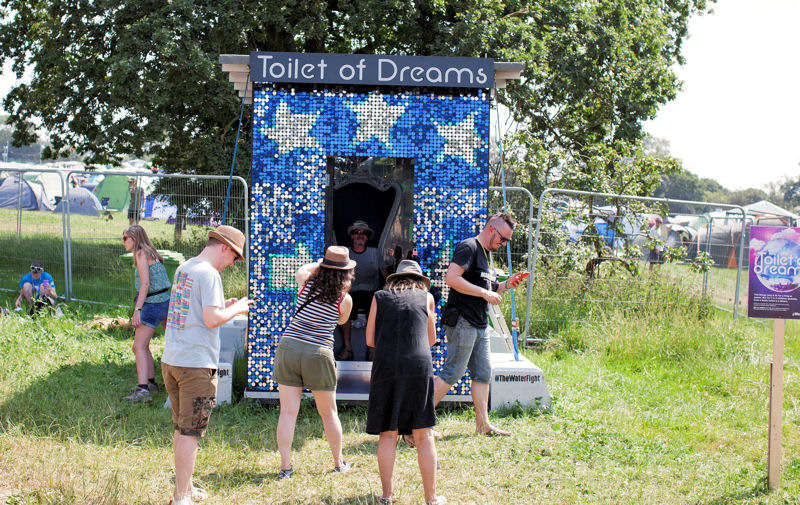WaterAid creates an eye-catching ‘toilet of dreams’ to convey a serious message about sanitation

A festival-goer enjoys WaterAid’s ‘Toilet of Dreams,’ the most luxurious lavatory on-site at the 2017 Glastonbury Festival. Photo courtesy of WaterAid, Emily Graham.
One of the big attractions at the 2017 Glastonbury Festival — a 5-day contemporary performing arts festival that takes place periodically near Pilton, Somerset, in the United Kingdom — was outfitted with a disco ball, mirrored walls, and even a throne. But this was not a posh lounge where people could talk and drink. It was what international non-profit WaterAid (London) coined the “Toilet of Dreams,” a blinged-out public bathroom that any festival-goer could use.
Jo Lehmann, media officer for WaterAid, said the Toilet of Dreams offered attendees the chance to become “king or queen of the latrine as they sat on the sliver throne, complete with a disco-themed purple toilet seat, surrounded by disco balls, mirrors, and a very special dream-themed soundtrack.”
The Toilet of Dreams wasn’t just an eye-catching stunt. Festival-goers not only got to try out this unique bathroom, but also learn how important reliable sanitation can be, especially in developing parts of the world. Lehmann said a message like this definitely comes across at a crowded music festival.
“Without home comforts — whether queuing to get water, waiting to use the toilet, or not being as clean as they’d like to be — festival-goers could start to understand what it’s like for those living without clean water or access to a decent toilet,” Lehmann said.
A tale of two toilets

A festival-goer poses in front of WaterAid’s ‘Toilet of Dreams’ at the 2017 Glastonbury Festival. Photo courtesy of WaterAid, Emily Graham.
This isn’t the first time WaterAid has hosted toilets at the Glastonbury Festival. Last year, the organization hosted three “talking toilets” voiced by the actor Brian Blessed, comedian Kathy Burke, and the musician DJ Cerys Matthews. While using the loo, festival attendees learned from the narrators about how important it is to have a toilet and proper sanitation, something that is not available to 2.3 billion people globally. The talking toilets also featured a one-way mirror on the door that allowed those inside the bathrooms to see outside and look out at the crowd of 200,000 people and performance stages.
This year, WaterAid did without the one-way mirrors and voiceovers, but the Toilet of Dreams was still a big — but not expensive — undertaking.
“WaterAid was very fortunate in that we received a lot of donations for the Toilet of Dreams,” Lehmann said. “The team that upholsters the Formula 1 racing cars kindly upholstered the throne using purple [polyvinyl chloride] material and silver studs. A team of builders at Tactical Live [Banbury, England] donated their time and labor costs and delivered it to Glastonbury on a large truck. And our friends at Shimmerwalls [Milton Keynes, England] designed and donated the sequined shimmer panels, which went on the outside of the toilet.”
A main attraction with a message
Even though the toilet was attention-grabbing, WaterAid needed to make sure its water- and wastewater-education message came across to those at the festival.
“A sign was displayed outside the Toilet of Dreams, explaining that one in three children globally don’t have access to decent toilets,” Lehmann said. “Without [toilets], children get sick, drop out of school, and aren’t able to fulfill their potential and achieve their dreams.”

In addition to taking photos in the Toilet of Dreams, Festival-goers learned about WaterAid’s #TheWaterFight to provide clean water and decent toilets around the world by 2030. Photo courtesy of WaterAid, Emily Graham.
Lehmann said WaterAid also had an “army of WaterAid volunteers” outside the toilet and across the rest of the site, urging festival-goers to join the global campaign #TheWaterFight, which “aims to make clean water and decent toilets normal for every child by 2030.” She said the volunteers also encouraged people to sign a petition “that calls upon the United Kingdom government to include taps and toilets for every child in their plans for schools worldwide.”
The Toilet of Dreams and the campaign were both a success. Lehmann said there was a long line of people waiting to use the toilet “because people liked the novelty factor of being able to sit on a silver throne whilst doing their business.” In addition, more than 30,000 people joined #TheWaterFight campaign during the festival.
“The petition will be presented to the U.K. government in September,” Lehmann said.
WaterAid has plans to return to the Glastonbury Festival in 2019, Lehmann said. They likely won’t in 2018 because “it’s a fallow year [for festivals] at Glastonbury,” she explained, to allow ground to recover from the foot-traffic by attendees. “But World Toilet Day, which takes place on Nov. 19, is fast approaching, and while we’re not looking to use the Toilet of Dreams, we do have some exciting plans of engaging the U.K. public about the humble loo,” she said.
— LaShell Stratton-Childers, WEF Highlights








September 14, 2017
Featured